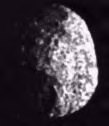
|
Diameter: 30,800 miles (49,500 km). |
|
Mass: 17.2 Earth masses |
|
Rotation period: 0.67 days. |
|
Inclination of equator to orbit: 29.6 degrees. |
|
Mean orbital speed: 3.3 Miles per second (5.4 km/s) |
|
Mean distance from the sun: 2.8 billion miles (4.5 billion km) |
| THE STRUCTURE OF NEPTUNE After the discovery of Uranus it was noticed that its orbit was not as it should be in accordance with Newton's laws. It was therefore predicted that another more distant planet must be perturbing Uranus' orbit. The planet was first discovered by Galle and d'Arrest in 1846, although in 1613 Galileo observed Neptune when it happened to be very near to Jupiter, but he thought it was just a star. Neptune has only been visited by one spacecraft. When Voyager 2 approached the solar systems eight planet in August 1989, scientists were uncertain what it would fine – would it appear as featureless and static as Uranus? However instead of a bland cue ball planet , scientists saw a great dark oval, dark bands and numerous strata of whispy white clouds. Neptune's composition and structure resemble those of its larger neighbour, Uranus. An iron silicon core, overlain with a mixture of various ices and rock, is thought to lie at its centre. The atmosphere is mostly hydrogen and helium gas with traces of methane. Temperatures in the upper part of the atmosphere, as on Uranus, are so low that methane freezes, yet unlike Uranus Neptune radiates more than twice as much energy as it receives from the sun, suggesting the evidence for an internal source of heat, and in turn it is this energy that would power the planet's violent winds and storms. When Voyager 2 looked at Neptune in 1989 the planets southern hemisphere was dominated by an oval shaped huge pressure region nearly 6000 miles in length and with supersonic winds flowing at its periphery. Below this great dark spot was a smaller storm dubbed the small dark spot. The space craft also images a small irregular white cloud which was christened 'scooter' because of its rapid motion. The cloud, according to astronomers, may have been an upwelling plume from the lower atmosphere. In 1995 observations of the planet by the Hubble space telescope confirmed the dynamic nature of the atmosphere – yet there was no trace of either dark spot, and new features had actually emerged. The spots either faded, as Jupiter's great red spot does from time to time, or dissipated altogether. It is also an interesting fact that due to the orbit of Pluto being eccentric, it sometimes crosses the orbit of Neptune, making Neptune the most distant planet from the sun. RINGS AND MOONS Neptune has a tenuous ring system containing some bright clumps, distributed along the rings arc. There are only four known rings, and because they are so distant and faint, precious little is known about them. Earth based observations showed only faint arcs instead of complete rings, yet the images relayed from Voyager 2 showed them to be complete rings.
Of the satellites that surround the planet, Triton is the largest with a diameter of 1700 miles, which is about two thirds the size of our moon, and a little larger than Pluto. With minimum temperatures of around –400F, Triton's surface s certainly as cold as Pluto's, and indeed its composition of rock and ice is also thought to resemble that of the most outward planet. Upon examination of its surface there are clearly impact craters, which we have seen on many moons, yet there also seems to be what can only be described as dimpled areas of pits and depressions. In some places nitrogen gas shoots upwards from vents for 5 miles (8km) into the thin atmosphere of nitrogen vapour, before wafting downwind to form dark plumes on the ground. Triton orbits Neptune in a retrograde manner, that is in the opposite direction to the planets rotation. A further moon, that of Neried, swings around Neptune in a long ellipse, and so eccentric is its orbit that its distance from Neptune varies by more than 5 million miles.
|
![]() Copyright(C) 2007
- 2020. All rights reserved.
Copyright(C) 2007
- 2020. All rights reserved.



